Are you looking to spruce up your living space but not sure where to start? Wondering how not to decorate your home in a way that’s simply disastrous?
Whether you just moved into a new place or are giving your current home a makeover, the importance of good home decor cannot be overstated. In this article, we’ll explore the pitfalls to avoid when decorating your home and offer some guidance on how to create a space that is both beautiful and functional.
One common mistake people make when decorating their homes is overcrowding. It’s easy to fall into the trap of cluttering every corner with furniture and décor, but sometimes, less is truly more. We’ll delve into why embracing minimalism can actually make a stronger design statement and create a more serene atmosphere.
Another crucial aspect of home decor is color coordination. Choosing an incohesive palette can result in a chaotic and jarring look for your space. From clashing colors to overwhelming patterns, we’ll discuss the importance of selecting a cohesive color scheme and how it can transform the overall feel of your home.
As we continue our exploration of the importance of good home decor, we will also touch on the significance of quality versus budget-friendly pieces, often neglected areas such as entryways, proper lighting choices, balancing aesthetics with functionality, personalizing your space, and avoiding blindly following fleeting trends. Join us as we navigate through the do’s and don’ts of creating a well-decorated home.
Overcrowding
When decorating a home, one common mistake that many people make is overcrowding the space with too many items. Whether it’s furniture, decor, or accessories, less is often more when it comes to creating a visually appealing and functional living space. Here are some reasons why overcrowding should be avoided in home decor:
- Visual appeal: When there are too many items in a room, it can create a cluttered and chaotic appearance. This can make the space feel smaller and less inviting.
- Functionality: Overcrowded rooms can also hinder the functionality of the space. It may be difficult to move around and use the room for its intended purpose if there are too many things in it.
- Easier maintenance: A minimalist approach to home decor can also make cleaning and maintaining the space much easier. With fewer items to dust and organize, keeping the room looking tidy becomes a simpler task.
To avoid overcrowding in your home decor, consider taking a more minimalist approach. Choose quality over quantity when selecting furniture and decor pieces, and opt for multi-functional items that can serve more than one purpose. Additionally, don’t be afraid of empty spaces – they can help create a sense of openness and tranquility in your home. By embracing the “less is more” philosophy, you can create a well-balanced and visually appealing living environment.
Color Clashing
When it comes to home decor, choosing the right color palette is essential in creating a cohesive and harmonious space. Avoiding color clashing is crucial in achieving a well-balanced and visually appealing environment. Here are some tips to help you master the art of choosing a cohesive palette for your home:
- Consider the mood: Before selecting colors, think about the mood you want to create in each room. Warm tones like reds, oranges, and yellows can create a cozy and inviting atmosphere, while cool tones like blues, greens, and purples can evoke a sense of calm and relaxation.
- Stick to a limited color scheme: Limiting your palette to two or three main colors can help create a sense of cohesion throughout your home. You can then use different shades and tones of these colors to add depth and interest.
- Use color theory: Understanding the principles of color theory can be valuable when choosing a cohesive palette. Complementary colors (opposite on the color wheel) can create visual contrast, while analogous colors (next to each other on the color wheel) can provide a harmonious blend.
By paying attention to these considerations and taking the time to select a cohesive color palette for your home decor, you can create a space that is visually striking and balanced.
Remember that it’s not just about individual preferences-choosing the right colors can also affect your mood and overall well-being. So take the time to explore different options and find the perfect combination that suits both your style and functionality needs within your home.
Buying Cheap
When it comes to home decor, the allure of a good bargain can be hard to resist. However, buying cheap when it comes to decorating your home can often lead to more costs in the long run.
This is because low-quality items tend to have a shorter lifespan and may need replacing sooner than higher-quality pieces. In addition, cheaply made decor items may not hold up as well over time, leading to a less polished and cohesive look for your space.
Quality matters in home decor because it can significantly impact the overall ambiance of your home. Investing in well-made furniture, durable fabrics, and timeless pieces can elevate the look and feel of your space. High-quality items are often made with better materials and craftsmanship, resulting in a more luxurious and visually appealing home. While it may require a larger upfront investment, the longevity and timeless appeal of quality decor items make them a worthy investment.
In addition to aesthetic considerations, the quality of your home decor also impacts its functionality. Well-made furniture tends to be more comfortable and durable, making it suitable for everyday use. Quality linens and textiles can also offer better performance and longevity, ensuring that your home remains both stylish and functional for years to come.
| Importance | Details |
|---|---|
| Longevity | High-quality decor items have a longer lifespan |
| Ambiance | Quality impacts the overall look and feel of your space |
| Functionality | Well-made items are more durable and comfortable for everyday use |
Neglecting the Entryway
When it comes to home decor, the entryway is often overlooked or neglected. However, this space plays a crucial role in making a good first impression on visitors and setting the tone for the rest of your home. Neglecting the entryway can result in a missed opportunity to create a welcoming and inviting atmosphere for both guests and residents.
One of the most common mistakes when decorating the entryway is leaving it bare or cluttered with unnecessary items. A well-designed entryway should have a balance of functionality and style. This can be achieved by incorporating essential items such as a mirror, console table, or coat rack, while also adding decorative elements like artwork, plants, or a stylish rug. By carefully curating these elements, you can ensure that your entryway looks polished and organized.
Another aspect to consider when neglecting the entryway is poor lighting. Adequate lighting in this area is important not only for practical purposes but also for creating an inviting ambiance. Whether it’s natural light from windows or strategically placed lamps and fixtures, proper illumination can enhance the overall appeal of your entryway. Additionally, by incorporating lighting elements such as sconces or pendant lights, you can add a touch of elegance and sophistication to this space.
Ignoring Lighting
When it comes to home decor, one aspect that is often overlooked is proper lighting. Lighting plays a crucial role in setting the mood and ambiance of a space, yet many homeowners fail to give it the attention it deserves. Inadequate or improper lighting can make a room feel gloomy, unwelcoming, or even unfunctional. On the other hand, well-designed and carefully chosen lighting can completely transform the look and feel of a room.
One important consideration when it comes to proper illumination is the natural light available in a space. Maximizing natural light not only saves energy but also has numerous benefits for mental and physical health. This can be achieved by strategically placing mirrors, choosing window treatments that allow light to filter through, and opting for lighter wall colors that reflect natural light.
Another crucial aspect of proper illumination is the use of layered lighting. Instead of relying on a single overhead fixture, incorporating multiple sources of light such as task lighting, ambient lighting, and accent lighting can add depth and dimension to a room. By combining different types of lighting, homeowners can create a versatile and adaptable environment that suits various needs throughout the day.
It’s important to consider not only the functionality but also the aesthetics of lighting fixtures. Choosing fixtures that complement the overall style and theme of a room can enhance its visual appeal. Additionally, investing in high-quality bulbs and fixtures will ensure longevity and efficiency while adding value to your home decor.
| Aspect | Consideration |
|---|---|
| Natural Light | Maximizing natural light with mirrors, window treatments, and lighter wall colors |
| Layered Lighting | Incorporating task lighting, ambient lighting, and accent lighting for depth and adaptability |
| Aesthetics | Choosing fixtures that complement the room’s style and investing in high-quality bulbs |
Forgetting About Comfort
When it comes to decorating your home, finding the balance between functionality and aesthetics is crucial. It’s easy to get caught up in making your space look beautiful, but it’s equally important to consider how comfortable and practical it is for everyday use. Neglecting the comfort of your home can result in a space that looks great but doesn’t feel welcoming or serve its intended purpose.
Choosing Furniture for Comfort and Style
One common mistake when decorating a home is prioritizing style over comfort when selecting furniture. While a sleek, modern sofa may look stunning, if it’s uncomfortable to sit on, it will detract from the overall enjoyment of the room. When choosing pieces for your home, consider both their aesthetic appeal and how comfortable and functional they are. Look for furniture that not only complements the style of your home but also provides a cozy and inviting place to relax.
Creating Relaxing Spaces
Comfort in home decor goes beyond just furniture. It’s essential to create spaces within your home that are geared towards relaxation and unwinding. Whether it’s a cozy reading nook with soft lighting or a plush seating area in the living room, these spaces should prioritize comfort without sacrificing style. By incorporating comfortable seating, soft textiles, and soothing colors, you can create areas within your home where you can truly unwind and recharge.
Maintaining Proper Flow and Functionality
Beyond individual elements such as furniture and decor, the overall flow and functionality of your space also contribute to its comfort level. Avoid overcrowding rooms with too much furniture or clutter that hinders movement and creates an overwhelming environment. Make sure there is ample space to move around freely while maintaining an aesthetically pleasing layout.
Additionally, consider how each room will be used and ensure that its design serves its intended purpose while still being visually appealing. Striking a balance between functionality and aesthetics is key to creating a comfortable living environment in your home décor.
Not Personalizing
When it comes to decorating your home, one of the biggest mistakes you can make is not personalizing the space. Adding your unique touch to your home decor is essential for creating a space that reflects your personality and style. Without personalization, your home may end up feeling generic and lacking character.
Reflecting Your Personality
One of the key reasons for adding your unique touch to your home decor is to reflect your personality. Your home should be a reflection of who you are, showcasing your interests, passions, and style. Whether it’s displaying art pieces that hold sentimental value or incorporating items from your travels, personalizing your home allows you to create a space that truly feels like your own.
Creating a Sanctuary
Personalizing your home also plays a significant role in creating a sanctuary where you feel comfortable and at ease. By surrounding yourself with items that resonate with you, you can cultivate an environment that brings joy and comfort. This could mean integrating cozy textiles, incorporating elements of nature, or showcasing cherished mementos – all of which contribute to making your house feel like a home.
Making Memories
Another reason for adding a personal touch to your home decor is the opportunity to make memories. Whether it’s creating a gallery wall with family photos or displaying souvenirs from meaningful experiences, personalizing your space allows you to surround yourself with reminders of cherished moments and loved ones.
These personal touches can serve as conversation starters and evoke fond memories each time you enter the room. By making thoughtful choices in how you personalize the interior design of your home, you’ll be able to curate a living environment that nurtures creativity, happiness, and nostalgia.
Following Trends Blindly
In conclusion, it is important to be mindful of the potential pitfalls of blindly following trends in home decor. While it can be tempting to keep up with the latest fads and styles, it is essential to consider the longevity and practicality of these trends. Instead of constantly chasing after what is popular at the moment, focus on creating a timeless and personalized space that reflects your unique style and preferences.
By avoiding the trap of following trends blindly, you can ensure that your home decor will stand the test of time and not become outdated within a few years. This also allows for more flexibility and creativity in selecting decor items that truly resonate with you, rather than being dictated by what is currently popular in the market.
Ultimately, home decor should be a reflection of your personality and individuality. It should be a space where you feel comfortable and at ease, surrounded by pieces that hold meaning to you. By steering clear of blindly following trends, you have the opportunity to curate a home that is both stylish and authentic to who you are. So, when it comes to decorating your home, remember that timeless elegance often outweighs fleeting trends.
Frequently Asked Questions
What Not to Do When Decorating Your House?
When decorating your house, it’s important not to clutter your space with too many accessories or furniture. Overcrowding a room can make it feel cramped and uncomfortable.
It’s also a mistake to ignore the scale and proportion of the items you’re using to decorate – large pieces in a small room can be overwhelming, while small pieces in a large room can get lost.
How Do I Not Over Decorate My House?
To avoid over-decorating your house, start by choosing a cohesive color palette and sticking to it throughout your home. This will create visual harmony and prevent the space from looking chaotic.
It’s also important to resist the urge to fill every empty wall or corner with decorations – leaving some space unadorned will help the eye to rest and appreciate what is there.
What Are the Home Decor Mistakes People Usually Make?
One common home decor mistake people make is ignoring the importance of lighting. Proper lighting can completely change the mood and ambiance of a space, so it’s crucial not to overlook this element.
Another mistake is prioritizing style over comfort – while aesthetics are important, your home should ultimately be livable and comfortable for you and your family. Additionally, failing to personalize your space can make it feel cold and impersonal, so don’t forget to infuse your personality into your decor choices.

I’m thrilled to be your companion on this exciting journey through the world of home decor and design. With a passion for turning houses into homes and a keen eye for the finer details, I’m here to help you transform your living spaces into beautiful, functional, and meaningful havens.





